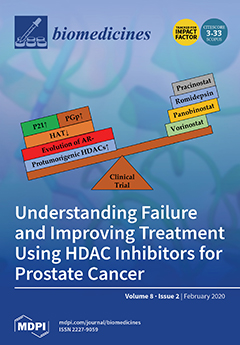Cumulative studies have provided controversial evidence for the prognostic values of bone morphogenetic protein 5 (
BMP5) in different types of cancers such as colon, breast, lung, bladder, and ovarian cancer. To address the inconsistent correlation of
BMP5 expression with patient survival
[...] Read more.
Cumulative studies have provided controversial evidence for the prognostic values of bone morphogenetic protein 5 (
BMP5) in different types of cancers such as colon, breast, lung, bladder, and ovarian cancer. To address the inconsistent correlation of
BMP5 expression with patient survival and molecular function of
BMP5 in relation to cancer progression, we performed a systematic study to determine whether
BMP5 could be used as a prognostic marker in human cancers.
BMP5 expression and prognostic values were assessed using different bioinformatics tools such as ONCOMINE, GENT, TCGA, GEPIA, UALCAN, PrognoScan, PROGgene V2 server, and Kaplan–Meier Plotter. In addition, we used cBioPortal database for the identification and analysis of
BMP5 mutations, copy number alterations, altered expression, and protein–protein interaction (PPI). We found that
BMP5 is frequently down-regulated in our queried cancer types. Use of prognostic analysis showed negative association of
BMP5 down-regulation with four types of cancer except for ovarian cancer. The highest mutation was found in the R321*/Q amino acid of
BMP5 corresponding to colorectal and breast cancer whereas the alteration frequency was higher in lung squamous carcinoma datasets (>4%). In PPI analysis, we found 31 protein partners of
BMP5, among which 11 showed significant co-expression (
p-value < 0.001, log odds ratio > 1). Pathway analysis of differentially co-expressed genes with
BMP5 in breast, lung, colon, bladder and ovarian cancers revealed the
BMP5-correlated pathways. Collectively, this data-driven study demonstrates the correlation of
BMP5 expression with patient survival and identifies the involvement of
BMP5 pathways that may serve as targets of a novel biomarker for various types of cancers in human.
Full article






